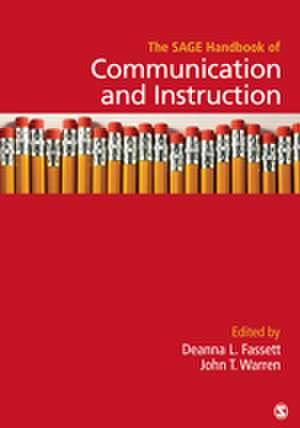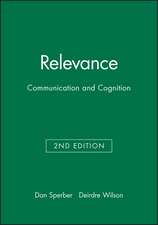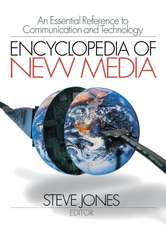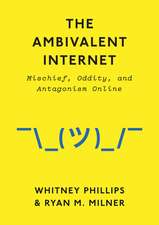The SAGE Handbook of Communication and Instruction
Editat de Deanna L. Fassett, John T. Warrenen Limba Engleză Hardback – 18 mai 2010
- Compiles original research and reviews of research in the intersections of communication and instruction from key figures in the disciplines, not only helping readers see present and future trajectories in this area of inquiry in foundational lines of research but also providing a sense of how this area has grown along a series of different theoretical and methodological approaches
- Helps readers identify avenues for research, in consultation with both key figures and innovators in this area of inquiry
- Serves as the primary contemporary and multi-paradigmatic guide to the study of the intersections of communication and instruction, recognizing all paradigmatic approaches and methods as meaningful
The Handbook will not only strengthen readers' interest in and comfort with different paradigmatic approaches to communication and instruction, but also make possible a generation of well-rounded, comprehensive, and effective researchers, capable of reading a broad array of work from a variety of approaches.
Preț: 1085.11 lei
Preț vechi: 1486.45 lei
-27% Nou
Puncte Express: 1628
Preț estimativ în valută:
207.70€ • 225.69$ • 174.58£
207.70€ • 225.69$ • 174.58£
Carte tipărită la comandă
Livrare economică 21 aprilie-05 mai
Preluare comenzi: 021 569.72.76
Specificații
ISBN-13: 9781412970877
ISBN-10: 1412970873
Pagini: 488
Dimensiuni: 178 x 254 x 30 mm
Greutate: 1 kg
Ediția:1
Editura: SAGE Publications
Colecția Sage Publications, Inc
Locul publicării:Thousand Oaks, United States
ISBN-10: 1412970873
Pagini: 488
Dimensiuni: 178 x 254 x 30 mm
Greutate: 1 kg
Ediția:1
Editura: SAGE Publications
Colecția Sage Publications, Inc
Locul publicării:Thousand Oaks, United States
Cuprins
Introduction: Critical Communication Pedagogy - Deanna L. Fassett and John T. Warren
SECTION I: Communication Education
Chapter 1: Communication Education: An Association of Radicals - Ann Darling, Section Editor
Chapter 2: The Philosophical and Methodological Foundations of Communication Education - Keith Nainby
Chapter 3: The Basic Course in Communication: Where Do We Go From Here? - Deanna D. Sellnow and Jason M. Martin
Chapter 4: Communication Across the Curriculum Problematics and Possibilities: Standing at the Forefront of Educational Reform - Deanna P. Dannels
Chapter 5: Communication and the Preparation of Future Faculty: Learning to Manage Incoherencies - Katherine Grace Hendrix
Chapter 6: Communication Textbooks: From the Publisher to the Desk - Matt McGarrity
Chapter 7: Learning through Service: The Contributions of Service Learning to the Communication Discipline - Jami L. Warren and Timothy L. Sellnow
SECTION II: Instructional Communication
Chapter 8: Instructional Communication: Section Introduction - Scott A. Myers, Section Editor
Chapter 9: Philosophical and Methodological Foundations of Instructional Communication - Jennifer H. Waldeck, Timothy G. Plax, and Patricia Kearney
Chapter 10: Power, Compliance, & Resistance in Classroom - Rebecca M. Chory and Alan Goodboy
Chapter 11: Instructor Immediacy: Creating Conditions Conducive to Classroom Learning - Paul L. Witt, Paul Schrodt, and Paul D. Turman
Chapter 12: Humor and Communication in Instructional Contexts: Goal Oriented Communication - Melanie Booth-Butterfield and Melissa Bekelja Wanzer
Chapter 13: Clarity in Teaching and Learning: Conundrums, Consequences and Opportunities - Scott Titsworth & Joseph P. Mazer
Chapter 14: The Relational Side of Instructional Communication: An Examination of Instructors? Presentational Communication Traits - Matthew M. Martin & Scott A. Myers
SECTION III: Critical Communication Pedagogy
Chapter 15: Critical Communication Pedagogy: A Reframing of the Field - John T. Warren and Deanna L. Fassett, Section Editors
Chapter 16: The (Critical) Pedagogy of Communication and the (Critical) Communication of Pedagogy - Leda Cooks
Chapter 17: Critical/Performative/Pedagogy: Performing Possibility as a Rehearsal for Social Justice - Bryant Keith Alexander
Chapter 18: When Will We All Matter?: Exploring Race, Pedagogy and Sustained Hope For The Academy - Bernadette Marie Calafell
Chapter 19: Critical Race Theory and Critical Communication Pedagogy - Jennifer S. Simpson
Chapter 20: Communication & Sexuality - Karen Lovaas
Chapter 21: Producing Digitally Mediated Environments as Sites for Critical Feminist Pedagogy - Radhika Gajjala, Natalia Rybas, Yahui Zhang
SECTION I: Communication Education
Chapter 1: Communication Education: An Association of Radicals - Ann Darling, Section Editor
Chapter 2: The Philosophical and Methodological Foundations of Communication Education - Keith Nainby
Chapter 3: The Basic Course in Communication: Where Do We Go From Here? - Deanna D. Sellnow and Jason M. Martin
Chapter 4: Communication Across the Curriculum Problematics and Possibilities: Standing at the Forefront of Educational Reform - Deanna P. Dannels
Chapter 5: Communication and the Preparation of Future Faculty: Learning to Manage Incoherencies - Katherine Grace Hendrix
Chapter 6: Communication Textbooks: From the Publisher to the Desk - Matt McGarrity
Chapter 7: Learning through Service: The Contributions of Service Learning to the Communication Discipline - Jami L. Warren and Timothy L. Sellnow
SECTION II: Instructional Communication
Chapter 8: Instructional Communication: Section Introduction - Scott A. Myers, Section Editor
Chapter 9: Philosophical and Methodological Foundations of Instructional Communication - Jennifer H. Waldeck, Timothy G. Plax, and Patricia Kearney
Chapter 10: Power, Compliance, & Resistance in Classroom - Rebecca M. Chory and Alan Goodboy
Chapter 11: Instructor Immediacy: Creating Conditions Conducive to Classroom Learning - Paul L. Witt, Paul Schrodt, and Paul D. Turman
Chapter 12: Humor and Communication in Instructional Contexts: Goal Oriented Communication - Melanie Booth-Butterfield and Melissa Bekelja Wanzer
Chapter 13: Clarity in Teaching and Learning: Conundrums, Consequences and Opportunities - Scott Titsworth & Joseph P. Mazer
Chapter 14: The Relational Side of Instructional Communication: An Examination of Instructors? Presentational Communication Traits - Matthew M. Martin & Scott A. Myers
SECTION III: Critical Communication Pedagogy
Chapter 15: Critical Communication Pedagogy: A Reframing of the Field - John T. Warren and Deanna L. Fassett, Section Editors
Chapter 16: The (Critical) Pedagogy of Communication and the (Critical) Communication of Pedagogy - Leda Cooks
Chapter 17: Critical/Performative/Pedagogy: Performing Possibility as a Rehearsal for Social Justice - Bryant Keith Alexander
Chapter 18: When Will We All Matter?: Exploring Race, Pedagogy and Sustained Hope For The Academy - Bernadette Marie Calafell
Chapter 19: Critical Race Theory and Critical Communication Pedagogy - Jennifer S. Simpson
Chapter 20: Communication & Sexuality - Karen Lovaas
Chapter 21: Producing Digitally Mediated Environments as Sites for Critical Feminist Pedagogy - Radhika Gajjala, Natalia Rybas, Yahui Zhang
Notă biografică
Deanna L. Fassett (Ph.D. & M.S., Southern Illinois University; B.A., University of California, San Diego) holds a Ph.D. in communication pedagogy from Southern Illinois University, where her dissertation, which suggests a corrective to the instructional communication study of "at-risk" students, received the university's dissertation research award. Now Associate Professor of Communication Studies, Fassett is the coordinator of the introductory course and Graduate Teaching Associate supervisor at San José State University. She has published her work in national journals, including Communication Education, Communication and Critical/Cultural Studies, and Basic Communication Course Annual.
Descriere
As the only multi-paradigmatic collection of research in the field, this Handbook brings together a comprehensive range of essays to serve as a fully inclusive resource. Deanna L. Fassett and John T. Warren, along with two section editors and twenty-nine additional contributors, provide a balanced overview of various paradigms in the field—social scientific, interpretive, and critical.
Key Features
Key Features
- Three sections, addressing overlapping issues in communication and instruction, collectively represent multiple paradigms. This allows the reader to experience the depth and nuance available in communications studies.
- Each perspective is granted its own foundational chapter to provide an orientation to the discipline.
- Each contributor sets the agenda for their approach, helping the reader identify where the field is headed and where future research might be beneficial.
- Besides reviews of extant literature, demonstrating where the field has been, this Handbook also includes chapters that share topical new findings.











